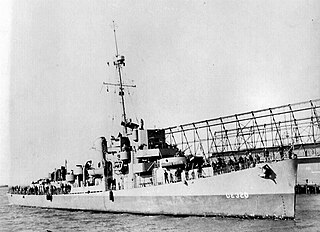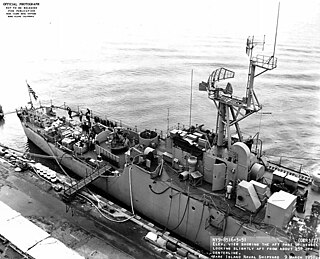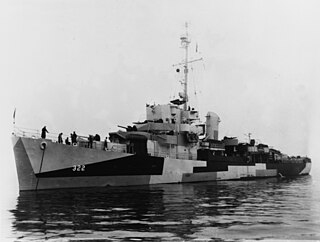
USS Abercrombie (DE-343) was a John C. Butler-class destroyer escort in the service of the United States Navy from 1944 to 1946. She was finally sunk as a target in 1968.

USS Hissem (DE-400/DER-400) was an Edsall class destroyer escort of the United States Navy. Hissem was constructed in 1943 as DE-400. In 1955, the vessel was equipped with modern radars, and the designation was changed to DER-400. The special purpose of DER ships was the detection of aircraft. Their chief role was to extend the DEW line out into the N. Atlantic and the N. Pacific oceans.

USS William T. Powell (DE/DER-213), a Buckley-class destroyer escort of the United States Navy, was named in honor of Gunner's Mate William T. Powell (1918-1942), who was killed in action, aboard the heavy cruiser USS San Francisco off Guadalcanal on 12 November 1942.

USS Atherton (DE-169), a Cannon-class destroyer escort, was the only ship of the United States Navy to be named for Lt. (jg) John McDougal Atherton, who died when USS Meredith sank near Guadalcanal during World War II.

USS Robert H. Smith (DD-735/DM-23) was the lead ship of her class of destroyer minelayers in the United States Navy.

USS Savage (DE-386) was an Edsall-class destroyer escort built for the United States Navy during World War II.

USS Menges (DE-320) was an Edsall-class destroyer escort built for the United States Navy during World War II.

USS Leopold (DE-319) was an Edsall-class destroyer escort built for the United States Navy during World War II. Named for Ensign Robert Lawrence Leopold to date it is the only United States Navy vessel to bear the name.

USS Pillsbury (DE-133) was an Edsall-class destroyer escort in service with the United States Navy from 1943 to 1947. She served again as a radar picket ship from 1955 to 1960 and was sold for scrapping in 1966.

USS Kretchmer (DE-329) was an Edsall-class destroyer escort built for the U.S. Navy during World War II. She served in the Atlantic Ocean and the Pacific Ocean and provided destroyer escort protection against submarine and air attack for Navy vessels and convoys.

USS Joyce (DE-317) was originally commissioned as a US Coast Guard Edsall-class destroyer escort built for the U.S. Navy during World War II. She served in the Atlantic Ocean and the Pacific Ocean and provided destroyer escort protection against submarine and air attack for Navy vessels and convoys. During its World War II service, on two different engagements with enemy submarines, the Joyce rescued survivors of the tanker SS Pan- Pennsylvania and its sister ship USS Leopold. Joyce received one battle star for its service during World War II.

USS Kirkpatrick (DE-318) was an Edsall-class destroyer escort built for the U.S. Navy during World War II. She served in the Atlantic Ocean the Pacific Ocean and provided destroyer escort protection against submarine and air attack for Navy vessels and convoys. Post-war, she was converted to a radar picket ship to support the DEW Line.

USS Lowe (DE-325) was an Edsall-class destroyer escort in service with the United States Navy from 1943 to 1946 and from 1955 to 1968. Between 1951 and 1954 she was loaned to the U.S. Coast Guard as USCGC Lowe (WDE-425). She was scrapped in 1969.

USS Newell was an Edsall-class destroyer escort built for the U.S. Navy during World War II. She served in the Atlantic and Pacific Oceans and provided destroyer escort protection against submarine and air attack for Navy vessels and convoys. Post war, she served in various capacities before being finally decommissioned.

USS Mills (DE-383) was an Edsall-class destroyer escort built for the U.S. Navy during World War II. She served in the Atlantic Ocean and the Pacific Ocean and provided destroyer escort protection against submarine and air attack for Navy vessels and convoys. Post-war, she performed additional duties for the Navy, including those of a radar picket ship and a safety and support ship for Operation Deep Freeze.

USS Haverfield (DE-393) was an Edsall-class destroyer escort built for the U.S. Navy during World War II. She served in the Atlantic Ocean and the Pacific Ocean and provided destroyer escort protection against submarine and air attack for Navy vessels and convoys.

USS Wilhoite (DE-397) was an Edsall-class destroyer escort built for the United States Navy during World War II. She served in the Atlantic Ocean and the Pacific Ocean and provided destroyer escort protection against submarine and air attack for Navy vessels and convoys.

USS Jaccard (DE-355) was a John C. Butler-class destroyer escort acquired by the U.S. Navy during World War II. The primary purpose of the destroyer escort was to escort and protect ships in convoy, in addition to other tasks as assigned, such as patrol or radar picket. Post-war, she returned home with one battle star to her credit.
USS Johnnie Hutchins (DE-360) was a John C. Butler-class destroyer escort acquired by the U.S. Navy during World War II. The primary purpose of the destroyer escort was to escort and protect ships in convoy, in addition to other tasks as assigned, such as patrol or radar picket. She served in the Pacific Ocean, and, post-war, she returned home with a Navy Unit Commendation awarded to her for her battle with Japanese midget submarines on 9 August 1945.

USS Vance (DE-387) was an Edsall-class destroyer escort, named after Joseph Williams Vance, Jr.



















